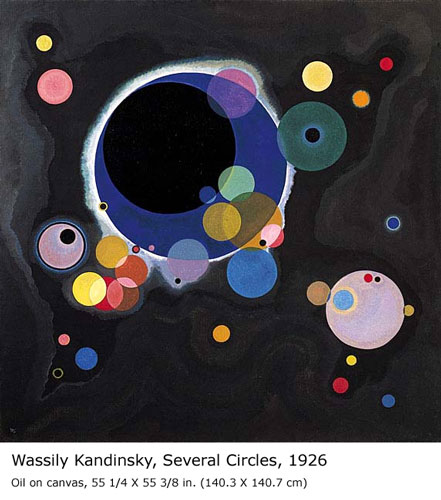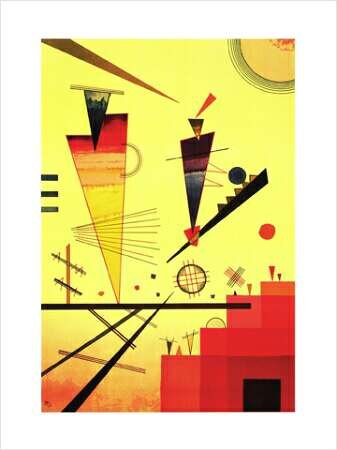History of Arts/20C
Wassily Kandinsky
@artnstory
2008. 5. 28. 00:58
칸딘스키 Kandinsky, Wassily
의 이러한 작품이 일본에서 본 작품들이었다.
칸딘스키는 두뇌가 비상한 예술가이다.
레오나르도 다빈치 같다고 해야하나?
그는 수학, 과학, 특히, 음악에 대단한 재주를 갖고 많은 악기를 다루었다고 한다.
하지만, 그의 모든 재주를 녹아들게 한 미술에 혼신의 열정을 갖고 작품에 몰두했으며, 바우하우스 교수가 되어 계속해서 구도와 구성 색채에 관한 작품을 시도하였다.
Composition X
1939 (160 Kb); Oil on canvas, 130 x 195 cm (51 1/8 x 76 3/4 in); Kunstsammlung Nordrhein-Westfalen, Dusseldorf
Biography
Born in Moscow in 1866, Kandinsky spent his early childhood in Odessa. His parents played the piano and the zither and Kandinsky himself learned the piano and cello at an early age. The influence of music in his paintings cannot be overstated, down to the names of his paintings Improvisations, Impressions, and Compositions. In 1886, he enrolled at the University of Moscow, chose to study law and economics, and after passing his examinations, lectured at the Moscow Faculty of Law. He enjoyed success not only as a teacher but also wrote extensively on spirituality, a subject that remained of great interest and ultimately exerted substantial influence in his work. In 1895 Kandinsky attended a French Impressionist exhibition where he saw Monet's Haystacks at Giverny. He stated, "It was from the catalog I learned this was a haystack. I was upset I had not recognized it. I also thought the painter had no right to paint in such an imprecise fashion. Dimly I was aware too that the object did not appear in the picture..." Soon thereafter, at the age of thirty, Kandinsky left Moscow and went to Munich to study life-drawing, sketching and anatomy, regarded then as basic for an artistic education.
Ironically, Kandinsky's work moved in a direction that was of much greater abstraction than that which was pioneered by the Impressionists. It was not long before his talent surpassed the constraints of art school and he began exploring his own ideas of painting - "I applied streaks and blobs of colors onto the canvas with a palette knife and I made them sing with all the intensity I could..." Now considered to be the founder of abstract art, his work was exhibited throughout Europe from 1903 onwards, and often caused controversy among the public, the art critics, and his contemporaries. An active participant in several of the most influential and controversial art movements of the 20th century, among them the Blue Rider which he founded along with Franz Marc and the Bauhaus which also attracted Klee, Lyonel Feininger (1871-1956), and Schonberg, Kandinsky continued to further express and define his form of art, both on canvas and in his theoretical writings. His reputation became firmly established in the United State s through numerous exhbitions and his work was introduced to Solomon Guggenheim, who became one of his most enthusiastic supporters.
In 1933, Kandinsky left Germany and settled near Paris, in Neuilly. The paintings from these later years were again the subject of controversy. Though out of favor with many of the patriarchs of Paris's artistic community, younger artists admired Kandinsky. His studio was visited regularly by Miro, Arp, Magnelli and Sophie Tauber.
Kandinsky continued painting almost until his death in June, 1944. his unrelenting quest for new forms which carried him to the very extremes of geometric abstraction have provided us with an unparalleled collection of abstract art.
Composition VIII
1923 (140 Kb); Oil on canvas, 140 x 201 cm (55 1/8 x 79 1/8 in); Solomon R. Guggenheim Museum, New York
보고 만질 수 없는 것을 그림으로 그린 화가 칸딘스키
그의 작품은 "눈으로 듣는 음악"
Black is like the silence of the body after death, the close of life.
-- Wassily Kandinsky, 1911
Kandinsky, Wassily, Russian in full VASILY VASILYEVICH KANDINSKY (b. Dec. 4 [Dec. 16, New Style], 1866, Moscow, Russia--d. Dec. 13, 1944, Neuilly-sur-Seine, Fr.), Russian-born artist, one of the first creators of pure ab straction in modern painting. After successful avant-garde exhibitions, he founded the influential Munich group Der Blaue Reiter (The Blue Rider; 1911-14) and began completely abstract painting. His forms evolved from fluid and organic to geometric and, finally, to pictographic ( e.g., Tempered ?an, 1944).
Encyclopaedia Britannica, 1994
Kandinsky, himself an accomplished musician, once said Color is the keyboard, the eyes are the harmonies, the soul is the piano with many strings. The artist is the hand that plays, touching one key or another, to cause vibrations in the soul. The concept that color and musical harmony are linked has a long history, intriguing scientists such as Sir Isaac Newton. Kandinsky used color in a highly theoretical way associating tone with timbre (the sound's character), hue with pitch, and saturation with the volume of sound. He even claimed that when he saw color he heard music.
의 이러한 작품이 일본에서 본 작품들이었다.
칸딘스키는 두뇌가 비상한 예술가이다.
레오나르도 다빈치 같다고 해야하나?
그는 수학, 과학, 특히, 음악에 대단한 재주를 갖고 많은 악기를 다루었다고 한다.
하지만, 그의 모든 재주를 녹아들게 한 미술에 혼신의 열정을 갖고 작품에 몰두했으며, 바우하우스 교수가 되어 계속해서 구도와 구성 색채에 관한 작품을 시도하였다.
Composition X
1939 (160 Kb); Oil on canvas, 130 x 195 cm (51 1/8 x 76 3/4 in); Kunstsammlung Nordrhein-Westfalen, Dusseldorf
Biography
Born in Moscow in 1866, Kandinsky spent his early childhood in Odessa. His parents played the piano and the zither and Kandinsky himself learned the piano and cello at an early age. The influence of music in his paintings cannot be overstated, down to the names of his paintings Improvisations, Impressions, and Compositions. In 1886, he enrolled at the University of Moscow, chose to study law and economics, and after passing his examinations, lectured at the Moscow Faculty of Law. He enjoyed success not only as a teacher but also wrote extensively on spirituality, a subject that remained of great interest and ultimately exerted substantial influence in his work. In 1895 Kandinsky attended a French Impressionist exhibition where he saw Monet's Haystacks at Giverny. He stated, "It was from the catalog I learned this was a haystack. I was upset I had not recognized it. I also thought the painter had no right to paint in such an imprecise fashion. Dimly I was aware too that the object did not appear in the picture..." Soon thereafter, at the age of thirty, Kandinsky left Moscow and went to Munich to study life-drawing, sketching and anatomy, regarded then as basic for an artistic education.
Ironically, Kandinsky's work moved in a direction that was of much greater abstraction than that which was pioneered by the Impressionists. It was not long before his talent surpassed the constraints of art school and he began exploring his own ideas of painting - "I applied streaks and blobs of colors onto the canvas with a palette knife and I made them sing with all the intensity I could..." Now considered to be the founder of abstract art, his work was exhibited throughout Europe from 1903 onwards, and often caused controversy among the public, the art critics, and his contemporaries. An active participant in several of the most influential and controversial art movements of the 20th century, among them the Blue Rider which he founded along with Franz Marc and the Bauhaus which also attracted Klee, Lyonel Feininger (1871-1956), and Schonberg, Kandinsky continued to further express and define his form of art, both on canvas and in his theoretical writings. His reputation became firmly established in the United State s through numerous exhbitions and his work was introduced to Solomon Guggenheim, who became one of his most enthusiastic supporters.
In 1933, Kandinsky left Germany and settled near Paris, in Neuilly. The paintings from these later years were again the subject of controversy. Though out of favor with many of the patriarchs of Paris's artistic community, younger artists admired Kandinsky. His studio was visited regularly by Miro, Arp, Magnelli and Sophie Tauber.
Kandinsky continued painting almost until his death in June, 1944. his unrelenting quest for new forms which carried him to the very extremes of geometric abstraction have provided us with an unparalleled collection of abstract art.
Composition VIII
1923 (140 Kb); Oil on canvas, 140 x 201 cm (55 1/8 x 79 1/8 in); Solomon R. Guggenheim Museum, New York
보고 만질 수 없는 것을 그림으로 그린 화가 칸딘스키
그의 작품은 "눈으로 듣는 음악"
Black is like the silence of the body after death, the close of life.
-- Wassily Kandinsky, 1911
Kandinsky, Wassily, Russian in full VASILY VASILYEVICH KANDINSKY (b. Dec. 4 [Dec. 16, New Style], 1866, Moscow, Russia--d. Dec. 13, 1944, Neuilly-sur-Seine, Fr.), Russian-born artist, one of the first creators of pure ab straction in modern painting. After successful avant-garde exhibitions, he founded the influential Munich group Der Blaue Reiter (The Blue Rider; 1911-14) and began completely abstract painting. His forms evolved from fluid and organic to geometric and, finally, to pictographic ( e.g., Tempered ?an, 1944).
Encyclopaedia Britannica, 1994
Kandinsky, himself an accomplished musician, once said Color is the keyboard, the eyes are the harmonies, the soul is the piano with many strings. The artist is the hand that plays, touching one key or another, to cause vibrations in the soul. The concept that color and musical harmony are linked has a long history, intriguing scientists such as Sir Isaac Newton. Kandinsky used color in a highly theoretical way associating tone with timbre (the sound's character), hue with pitch, and saturation with the volume of sound. He even claimed that when he saw color he heard music.








